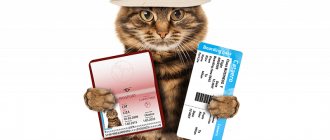If a kitten has not been accustomed to traveling by transport from an early age, each trip can be unpleasant for him - a sudden change of environment and unfamiliar sounds and smells risk turning into stress for the tailed one.
Therefore, from an early age , a kitten should start riding in a car, bus or other transport (only if the pet has already been vaccinated). Young animals learn to get used to new situations faster than adults, and this is the key to avoiding problems with trips in the future. Our tips will also help you avoid them: with them, the trip should go smoothly and without incident.
Features of transporting cats by ground transport
If the animal is not afraid of the street and is quite calm, then you can not spend money on carrying it, but use an ordinary sports or shopping bag. In this case, it is better to leave the pet’s head outside, and hang the bag itself on a belt in front or on the side of the shoulder. This way the cat won't be nervous.
You should not carry your pet in your bosom, it can be dangerous. The animal may become frightened and run away, scratching its owner. And anything can scare a cat on the street, be it the loud sound of cars or children's screams.
A plastic carrier is best for transporting your pet in a car. It is better not to transport a cat without it, because the animal may unexpectedly rush at the driver or quietly run away during a stop.
A lightweight fabric bag with mesh windows is perfect for carrying a cat in your arms. This way the pet will be able to see everything that is happening around and breathe freely.
For heavy and large cats, you can buy a carrier with wheels. The animal will be comfortable in it and the owner will not get tired of wearing it. To travel with a pet by train, it is better to use a special travel house.
If there are two cats, then you can use strollers and carriers with two compartments to transport them. There are special insulated bags for transporting animals in winter.
Transporting a cat on an airplane
If everything is more or less clear when it comes to transporting cats on the ground, then what about in the air? Consequently, a logical question arises - how to transport a cat on an airplane? As you know, it is prohibited to take animals into the aircraft cabin; they are placed in the luggage compartment. And in general, a flight is always stressful, even for a person. What can we say about animals?
For such cases, it is necessary to purchase a strong plastic bag so that the cat does not get hurt during the flight from some heavy suitcase accidentally falling on it. The carrier must be equipped with a drinking bowl so that the pet can quench its thirst at any time.
Train ride
If you have to travel long distances, many people choose a train as their means of transport. Fast, inexpensive, comfortable, but what about a pet? In order for the trip to go smoothly, you need to know in advance how to transport a cat on the train. First of all, you need to contact a veterinarian. Many animals have their own passport, which contains all the data on the cat’s health status and vaccinations performed on it.
It is extremely important to get a rabies vaccination if you do not have one. Without it, the tailed passenger may simply not be allowed onto the train.
In Russia, such a vaccine is offered free of charge in state veterinary hospitals.
The owner will also need to take a certificate from a veterinarian; it is better to take it immediately before leaving, since it is valid for only 3 days. In the certificate, the doctor will indicate which animal will be transported; several animals can be entered in one certificate if they are traveling together. Also, the obligatory notes will include the age of the animal and quarantine marks, if any.
It is important to know! If there is no such certificate, the conductor has the right to refuse to transport the animal.
Traveling by train can last from several hours to several days, so you need to take care of your pet in advance. It is more convenient to take for her foods that she is accustomed to, of course, dry food. There must be water. The cat will definitely want to go to the toilet; you can use a regular absorbent diaper. If the cat is accustomed to a harness, you can also take it with you; perhaps the pet will want to walk around the carriage or platform while waiting to board.
How to transport a cat in a car
A personal car is considered the most convenient means of transportation. There is no need to prepare all documents and other nuances. But, only if the trip is not for the purpose of taking part in an exhibition or if the animal is to be sold. In these cases, documents and an animal passport are needed.
The cat can be transported in a special carriage, in the back seat. Or just in the back seat, if the cat is already familiar with transport and has already traveled before. It is advisable to have a person in the back seat with the cat.
Long distance transportation
To transport a cat over long distances, you must obtain certificates from the veterinarian about the pet’s health status and vaccinations.
It should be remembered that you need to transport your cat, as it will be more comfortable for her. Therefore, you need to allow him to settle in and sniff the purchased carrier in advance.
Let's go
If you are traveling by car and have time, don't start right away. Sit for a while and let your pet get used to the new place so that transporting your cat in the car is stress-free and adventure-free.
Then, don't forget to fasten your carrier with a seat belt and hit the road.
The nuances of transferring an animal to alternative feeds
In most cases, dietary changes do not go completely smoothly. An animal accustomed to a certain feeding gets used to constant nutrition and finds it quite difficult to refuse it. In this case, even if you know how to properly switch a cat to another food, this does not mean that your pet will be delighted with the changes and immediately switch to a new food, giving up his favorite treats.
The main thing that a cat owner will need in order to make the transition to a new food is patience. The innate cunning of cats allows them to quite successfully manipulate their owners, clearly showing their negative attitude towards the new food. Some animals strive to “bury” the new food offered to them, thus comparing it with litter for their toilet. Other animals, not paying attention to the food in the bowl, make a suffering face or meow painfully, demonstrating their hunger.
Travel registration
Nowadays, tickets are purchased in two ways, which determine the specifics of further actions:
Order a ticket via the Internet. As a rule, on the websites of railway companies, when purchasing a ticket, you can select all the additional functions, which include transporting a pet, which will increase the cost of the ticket.
Upon arrival at the station, you just need to show your passport and present the ticket printed from the website; When ordering a ticket through the website, pay attention to the carriages marked with the letter Z - these are the ones you need
Purchasing a ticket through the station ticket office. When purchasing a ticket directly, you inform the cashier about the presence of the animal and discuss the package of necessary documents and the final cost of the ticket, after which you redeem it.
It is advisable to notify Russian Railways employees of your intention to transport the animal in advance (two to three days before the day of departure). You can do this by calling the toll-free number 8-800-222-07-66.
The simplest procedure for transporting a cat applies to all trains
Please note that commuter trains do not require containers. It is enough to pay an additional fee for the animal, and entry into the carriage is open.
We will equip the place
Carrying
The most reliable and safe place for a cat during a trip is a carrier - a container with a grille for air access and a door with a secure lock.
When choosing a good carrier, you need to pay attention to:
Scientists have found that cats are often susceptible to claustrophobia. The carrier should allow the pet to follow what is happening and see its owner. Some carriers have built-in bowls or trays for food and water.
Let's make a purchase . When choosing a carrier you need:
The carrier is placed in the back seat and securely secured with seat belts so that the container cannot slide around the cabin.
I recommend: How to get rid of cat hair in an apartment: examples at home
Bed
An animal that spends a long time in a carrier or inside a car needs bedding or a mattress:
- comfortable;
- soft;
- with replaceable cover.
Harness
How to choose a harness. The correct harness should:
Harness training. It is more difficult to train an adult cat to wear a harness. It is better to start doing test walks at home, so that the animal adapts to its usual conditions and calmly endures the restrictions of freedom.
Rules for transporting cats on an airplane: in the cabin and luggage
To make the flight comfortable and safe, you need to start preparing the animal a few days before the trip. It is advisable to introduce the cat to his carrier container, where he will spend several hours.
Sedatives should not be given. When a plane takes off and lands, a pressure drop occurs that affects the animal's cardiovascular system. Substances that are in the blood can only aggravate this, even to the death of the animal.
What is important to know when booking
Before booking, you need to check with the airline itself about the rules for transporting cats on the plane. This can be done via a hotline, at a ticket sales point, or on the carrier’s official website or ticket sales aggregators. You need to know a number of formalities:
- are there any restrictions on the transportation of animals;
- what conditions will the cat be in during the flight?
- what are the carrying requirements?
- how much does this service cost?
It is worth finding out how many animals can be on the plane at the same time. Some companies limit their number. The owner must obtain permission from the carrier to transport his pet. If the animal is transported in the luggage compartment, permission is obtained after purchasing the ticket, if in the cabin of the aircraft - before the ticket is purchased.
If you plan to fly internationally, you need to find out the transportation rules in force in another country. Sometimes quarantine is imposed on the import of any animals. Such measures are used in special cases and are quite rare, but to avoid unpleasant situations at the airport, it is better to discuss this in advance.
How to take a cat on board an airplane
Some carriers allow this, others, on the contrary, prohibit this. You need to find out these subtleties in advance, when booking a ticket, with the company itself. According to current regulations, only an adult and legally capable passenger can transport an animal in the cabin.
It is imperative that the cat is in a carrier, which must also meet certain requirements. The animal must weigh no more than 8 kg, which automatically deprives large breeds, such as Maine Coons, of this opportunity.
Cost of transporting a cat on an airplane
Transporting cats on an airplane is in most cases free of charge. Many owners want to take them to the salon. In this case, you need to pay for a boarding pass and register the cat as “special cargo.”
The average cost of transportation is about 4,000 on domestic flights and approximately 5,000 rubles on international flights. In this case, the airline must receive advance warning from the animal owner.
Is it possible to transport a cat unaccompanied?
This option is provided by most airlines. In this case, the cat moves in a special compartment with an optimal climate without being accompanied by its owner. To use this service you will need to provide a number of documents:
- copy of the owner's passport;
- veterinary passport of the animal;
- veterinary certificate;
The cost of the flight is paid twice; to calculate the exact amount, the weight of the carrier along with the animal, as well as its dimensions, are taken into account.
Receiving cats after a flight
After arriving at your destination, you can pick up your pet at a special place, which is located near the baggage claim point. You can find out the specific location at the check-in counter or an airport employee.
Usually animals are given out after luggage. They are transported on special carts. If there is a transfer to another plane, the animal will be transported by the airline services to the new flight.
What you need to transport a cat by train
Transporting a cat on a train is not the easiest test for its owners. It is unknown how the animal will behave during the trip, and the process may be complicated by the requirements of the railway company. To avoid unpleasant situations, there are a number of solutions that will help make this comfortable for both humans and cats.
Interesting article: all about the Abyssinian cat breed.
Which car is suitable: passenger or baggage
The only passenger carrier in our country is Russian Railways. If such a move is planned, it is better to find out in advance the existing rules of this state company in the field of transporting animals.
If you are using a shared carriage where the passenger is seated, you will need to pay extra for the cat and present a transportation ticket (receipt). There are other types of wagons that have different requirements.
Some trains provide only 1-2 seat compartments for transporting animals. This is a question worth asking when purchasing a ticket. Most often, you can only travel with an animal in a compartment carriage. This is dictated so as not to create inconvenience to other passengers. The main conditions for transporting animals by Russian Railways trains are listed in the table below:
Table of conditions for transporting animals in Russian Railways cars.
Cost of transporting cats on a train
Transporting a cat on a train has its own cost, which depends on the route, carriage, type of train and other factors. An additional fee is charged in reserved seat, seated and shared carriages. If the passenger travels in a compartment, no additional payment is required. The pet carrier is located in the place purchased by the owner.
If we are talking about high-speed trains, you will also have to pay extra. The “swallow” charges a fixed fee of 150 rubles. In Sapsan it is already included in the ticket price.
Transportation on long-distance trains
When transporting an animal, the owner must ensure sanitary and hygienic requirements, as well as the safety of other passengers.
Long-distance travel is considered to be a route longer than 700 km. The cost of transporting a cat will depend on the distance, for example, for a distance of more than 12,000 km the cost will be 3,000 rubles. To ensure your pet’s comfort, you must fulfill a number of requirements:
- ensure constant access to water;
- carry anti-motion sickness pills;
- If possible, at stations with a large parking lot, take the container with the animal into the fresh air and give her the opportunity to go to the toilet.
Also, when moving long distances, it is worth considering the cat’s diet. It is optimal to choose dry ready-made food. You should not feed your pet too often.
Transporting cats unaccompanied
The Russian Railways company offers transportation of pets without human accompaniment. This happens in the luggage compartment. The owner must write a corresponding statement at the box office and comply with a number of requirements:
- cage or special carrier;
- veterinary documents;
- food, water, hygiene products for the cat.
The cost of such a service is determined by the distance. During the entire journey, the animal will be under the supervision of train staff.
On a note
Attention
In severe, advanced cases, when it is necessary to transport a very nervous animal, a combination of drugs is also possible. For example, start using Feliway at home a week before your trip, and additionally use Fospasim an hour before departure and on the road. The French drugs Feliway and Adaptil () stand apart from traditional sedatives. They are produced in two versions: a spray and a diffuser like a fumigator, which is plugged into an outlet. Both drugs are certified in Russia. Their action is based on imitation of natural calming pheromones for the animal, a synthetic analogue of which is released when the diffuser is turned on or the spray is used. Their advantages (especially the diffuser) include ease of use, inconspicuousness for people, the ability to cover several animals at once if they live in the same room, as well as remote influence: there is no need to give or inject anything to the pet. Disadvantages include the high price, the need for prolonged exposure, and the fact that not all animals are susceptible to their effects. In addition, cats need their own drug (Feliway), dogs need their own (Adaptil), but for other species such drugs simply do not exist. In addition, if the living space is large, then several diffusers may be needed at once. And if an animal leaves the “controlled zone” in which the diffuser operates, then it immediately finds itself outside its field of action.
Elena Kvasova, practicing veterinarian
Preparing the cat for the trip
Before your trip, you need to take care of the most important thing - the mustachioed traveler. We put him on a small diet : it’s better for him not to eat 3-4 hours before the trip. This rule does not apply to water: you can give it to your pet. Cats can tolerate it for 24 to 48 hours, so it’s unlikely that a puddle will appear in the carrier.
If your animal often gets nervous while traveling, you should visit the veterinarian in advance . He can prescribe sedatives so that the pet does not worry. Opinions about such drugs are controversial in the veterinary community, but in some cases their use may be justified.
Never give medications without your doctor's advice. This is especially true for pharmaceutical products intended for people. It is also a good idea to check how your cat reacts to the drug in advance to avoid any surprises along the way. This issue should also be discussed with your veterinarian.
DIY options
How to make a house for a cat with your own hands: patterns
Making a cat carrier with your own hands is not as easy as it might seem at first glance. However, if you have the skills to use a needle or sewing machine, as well as the desire, then you can try. There are several ways you can make a cat carrier with your own hands; below are the most popular ones.
Bag pattern
You need to choose a thick fabric: tarpaulin or jeans. To form the bottom, it is recommended to use plastic or thin plywood, since the cardboard will quickly wrinkle under the weight of the animal. Then you should draw a pattern larger than the size of the animal and sew all the parts, starting from the bottom, on a sewing machine. To make transportation more convenient, it is recommended to attach a handle.
Pattern of a carrying bag for a cat
From the box
If you don’t have the time or opportunity to buy or sew a fabric carrier, you can build one out of a box. To do this, you will need to line the inside of the box with insulation. You need to attach handles to the outer part or immediately take a box of handles. The main thing is not to forget about the ventilation holes so that the cat has something to breathe.
Note! Such a carrier will have an unpresentable appearance, but it will withstand the journey to the dacha by car! The cat can behave unpredictably because the animal needs to look at the road, so it is recommended to cut out a window and cover it with plastic
From an old bag
If you have an old hard bag at home that holds its shape, you can make a carrier out of it. It is recommended to place the cat inside to see if the size is right for him. This will also help you figure out how hard the bottom of the bag is and whether it needs to be further sealed. If this is necessary, it is worth putting plastic or thin plywood into the bag according to the size of the bottom of the bag.
It is recommended to purchase several zippers and a mesh, which will act as ventilation and a porthole at the same time. Instead of one of the side walls, it is recommended to sew a mesh that can be opened with a zipper. A piece of the same width must be sewn on top so that the animal does not feel too cramped in the improvised carrier.
Other materials
An old school bag can also be used for these purposes. It is recommended to cut a hole from the outside for the porthole and cover it with plastic. To prevent the animal from breathing the glue, it is recommended to stitch it using a sewing machine. It is necessary to process all internal seams so that the cat cannot get hurt.
Important! It is necessary to make holes in the side walls that will allow air to pass through. Using a hot awl you can make holes in plastic.
How to transport a cat long distance
Every lucky cat owner has had to take their pet outside the house at least once in their life, at least to see a veterinarian or for a walk. It’s not difficult to deal with an animal within a couple of hours, but it’s much more difficult if you have a long journey ahead.
It is advisable to prepare the animal in advance for a long-distance move. If transportation is carried out by personal transport, the cat should be allowed to walk freely around the cabin, sniff the area, but under no circumstances should it be forced there. You can try driving after the animal is no longer afraid of the engine noise and for the first time not for long, the travel time increases gradually. According to safety precautions. cats in a car must be transported in a carrier; even if the pet is calm, it is impossible to predict how the cat may behave in an emergency situation. The dimensions of the carrier should allow the animal to stand up and turn freely, there should be no sharp corners, and it also needs to be accustomed to it in advance.
On the day of the trip, a harness is put on the animal, and only then can you put the pet in the carrier; the leash must be tied to the handle so that the cat does not run away at the bus stop. During stops, your pet should be given the opportunity to warm up and not be fed or watered for 6 hours both before and during the trip. In especially severe cases, a few days before travel, you can start giving a mild sedative (selected by a veterinarian).
You need to start preparing for transporting an animal by train or plane long before purchasing tickets. First, the animal is taken to the state veterinary clinic to receive an international passport, and the necessary vaccinations are also given there. You need to know in advance what vaccinations are required for import into a particular country. You may also need to install a chip. The same state veterinary clinic issues a certificate of the cat’s health status (valid for five days); at the airport it will be exchanged for an international veterinary certificate. On the way back, you also need to get a certificate from the local state veterinary clinic about the animal’s health condition.
You must obtain permission in advance from the airline to transport the animal and find out the necessary conditions for transportation. It is impossible to feed a cat a sedative before a flight; in combination with the pressure drop when climbing, it can cause death. It is better to cover the carrier with a dark, thick cloth, but so as not to block the air, the cat will panic less. Bedding or disposable diapers should be laid so that the pet does not chew them. The animal cannot be fed and watered throughout the trip and 6 hours before it.
When transporting by train, the same documents are collected as for air travel, and a baggage receipt is purchased. However, you cannot transport your pet in luxury and SV carriages. Cats, like other animals, are transported in compartment cars, while all seats are purchased and 20 kg of luggage per animal are paid for and a note is made on the receipt (“baggage in the hands of the passenger”).
How to transport a cat long distance
How to prepare documents for transportation
The rules for transporting cats state that the airline must be warned in advance that the passenger is flying with his pet. This must be done at least 36 hours before the flight. You must have certain documents with you, without which the animal cannot be brought on board the plane.
Documents for transporting a cat in Russia
The rules for transporting cats on an airplane in Russia set standards that are a little more loyal and simpler than transportation on international routes. For domestic flights you need to have:
- Veterinary passport. It is issued by a veterinary clinic, it indicates all the mandatory vaccinations that the animal must have.
- State certificate No. 1. It can be obtained from the State Veterinary Station.
- Certificate of completed microchipping.
Documents must be completed in advance. An animal that does not have mandatory vaccinations, according to current legislation, cannot be allowed on board the aircraft.
Documents for taking a cat abroad
If you are planning an international flight, the documents must be as follows:
- international veterinary passport;
- certificate of the value of the animal (exporting animals from the Red Book and those with a special status is prohibited by law);
- certificate of breeding value;
- veterinary certificate No. 1;
- the animal must be microchipped;
The latest certificate must be exchanged at the check-in counter at the airport and instead obtained from an airline employee an international veterinary certificate, which is accepted by all countries of the world, wherever the passenger flies. This document must be kept and presented at the airport of arrival. If there is a return flight, this document will also be required.
Interesting read: everything about Turkish Angora cats.
What vaccinations will be needed?
Transporting a cat on an airplane requires vaccination. The pet must have had a rabies vaccination within the last year, but no less than 20 days before the flight. According to EU requirements, this period is 21 days. It is worth using a drug that does not contradict veterinary standards in the country of arrival. A veterinarian will help you choose one.
It is also necessary to have marks about panleukopenia. A special sticker with the date, drug, signature and stamp of the doctor is placed in the passport. The animal must undergo anthelmintic treatment.
Question to the expert
Do all countries have the same standards for transporting cats?
Depending on the country, there are other requirements. Before purchasing a ticket, you must find out all the current requirements and pass them. It is better to do this in advance, preferably a month before the upcoming flight.
Get to know the carrier
It is advisable to purchase a transport box or bag before your pet arrives at home. The kitten will quickly get used to the new house, and it will be easier to teach it any tricks. An adult pet will need a little more time to get used to the box. If you are planning a trip with your cat, you need to place a portable house in advance in your pet’s favorite place so that he gets to know it. It is advisable to leave the animal alone in a closed room and give it the opportunity to sniff an unfamiliar object. You can introduce a new product by putting your hand with a toy in the carrier and luring the cat with movements. At the same time, you should speak to him in kind words. Don’t be upset if your pet doesn’t want to come into contact with the carrier and stays away
This is natural, because animals always treat everything incomprehensible with caution. It may take more than one day for the cat to understand that the new home is completely safe.
After this, the little hunter will begin to examine the strange box with great interest, and will experiment with the purpose of the house - what is the best way to adapt it. It is advisable to place the carrier in the place where the cat spends most of its time, for example, near the bed or near the sofa.
Possible problems and advice from experienced travelers
Microchip implantation
The main idea of chipping is to make it easier to find “lost items” so that if found, they can be returned to the owner. Also, all information about a given belly is recorded on the chip, including its vaccinations, diseases and other data.
What does a cat need on the road?
In order for your pet to survive a long trip, you need to have some items with you. Be sure to stock up on the following:
All of these items will be useful, especially during a long trip.
I recommend: Why does a cat eat fur and why is it dangerous?
Is a container required for transportation?
A bag for transporting cats is a must, regardless of the chosen transport. It is not recommended to take out an animal while traveling, since in a state of fear it can simply run away, bite, scratch and escape from your hands.
The nuances of transporting kittens
Sedatives for cats
Using sedatives will reduce your cat's stress. It is advisable to coordinate the choice of a specific drug with your veterinarian. If you plan to travel by plane, sedatives for cats during transportation can be dangerous.
An overdose of the drug can also only cause problems, and sometimes even cause death.
How to prepare a cat for flight
For several days, the cat’s food should be limited, but not completely. Access to water must remain unrestricted. It is worth preparing a carrier, toys and other necessary items in advance.
Should you feed and water your cat before and during the flight?
It is better not to feed the animal during the day or during the flight. The cat is under stress and therefore will not be interested in food. The last feeding should be four hours before departure.
What happens to a cat when it suddenly travels?
Transporting dogs in a car over long distances
An unsuspecting cat who is suddenly thrust first into a carrier and then into a car is inevitably faced with extreme stress. Therefore, owners should know in advance how cats cope with the road in the car.
A cat caught by surprise is not ready for such a test, which can negatively affect its emotional state. Especially when it comes to adults and elderly animals. It is easier for young people to adapt to changes than for adults.
Against this background, the cat may lose its appetite. Being in a prolonged state of fear will make her intimidated, nervous, perhaps even aggressive. Those who have ever carried cats in a car are well aware of the problems with the toilet: the cat may shit in the car or start burping.
To avoid such problems, owners should think in advance about how to prepare their cat for traveling by car.
Final preparations
When packing your bags, take food and water for the animal, and wet wipes and disposable diapers will ensure hygiene. By sprinkling a little stuffing on the diaper, you can get rid of the unpleasant odor while traveling. In winter, a warm blanket will be useful. If you are worried that the cat will not survive the trip well, the veterinarian will prescribe a safe sedative or recommend a drug for motion sickness.
By taking care of everything in advance and accustoming the animal to the container, you can count on the trip or flight to go smoothly.
Interesting topics
What else to read:
- How to stop a cat from climbing on the table and stealing food Contents of the article Why is it interesting for a cat to climb on the table Feeding rules for owners How.
- Estrus in a cat: what the owner needs to know Contents of the article Frequency and duration of estrus How estrus manifests itself in cats How to alleviate it.
- Disabled cats: how to care? Contents of the article Solving urination problems Defecation problems How to feed a disabled cat? Massage and physical.
- Increased temperature in a cat: how to measure and help Contents of the article Why does the temperature rise? How and how to measure the temperature of a cat First aid.
© Veterinary clinic "Belanta", 2004—2021, Moscow
What happens to a cat when it suddenly travels?
How are animals usually transported? In most cases, the cat is simply picked up and forced into a carrier, then taken to an unfamiliar place. Sometimes the journey takes several days.
What happens in this case? Imagine, a cat lived in an apartment for several years, saw the world around him from a window or balcony, and there are so many new things here. New smells, sounds, strangers, transport, screams, barking...
An animal from a familiar environment suddenly finds itself in another world, and everything unidentified causes fear. When there is danger, a natural mechanism is triggered: run away or defend yourself.
When a cat cannot escape, it freezes and practically does not react to others.
If you have been to clinics where there is an inpatient facility, you most likely noticed how calmly the animals left for treatment behave. They can easily give an injection or connect a system, that is, an IV, or carry out other necessary manipulations
Yes, of course, they feel bad about it and already agree to everything. But if you compare a sick animal at home and in a clinic, these are two big differences.
In her apartment, a sick cat will defend herself to the last, sometimes the whole family has to hold her for a routine examination. And when it comes to complex manipulations, it becomes completely difficult.
Why am I making such a long digression and telling you different stories about the clinic and IVs? To draw your attention to some points. It may seem to you that the animal bravely endures the trip, sits calmly in the carrier and does not even meow
This may be true, but most often the cat is under severe stress, it freezes and does not make any sounds. We see calm outside, but what is happening inside is not noticeable
It may seem to you that the animal bravely endures the trip, sits calmly in the carrier and does not even meow. This may be true, but most often the cat is under severe stress, it freezes and does not make any sounds. We see calm outside, but what is happening inside is not noticeable.
And inside the whole body is preparing to fight with all its strength or run as fast as possible. Adrenaline is produced, blood supply to the brain and muscles improves, sense organs are sharpened, more oxygen is supplied, and reserves are used.
An hour or two passes, but the causes of stress do not disappear - we continue the journey, we can still hear the noise of the crowd, foreign smells, and changes in temperature.
Exhaustion sets in, the body cannot constantly be in constant mobilization. In such situations, the cat may begin to make loud noises, scratch the carrier, urinate, and lick itself nonstop. Or he will completely stop reacting to what is happening.
Prolonged or severe stress can lead to serious complications. Neurosis, decreased immunity, exacerbation of chronic diseases, allergies and other disorders are often observed.
It has been noticed that after a trip, a cat more often suffers from infectious diseases, digestive disorders, autoimmune pathologies appear, and chronic ones worsen.
We provide food and drink
Many owners prefer not to feed their pet on the road, but if the journey is long and the animal is accustomed to eating at a certain time, then you should worry about providing it with food and water.
The best food option. When choosing food, it is better to give preference to dry food or small packages with pieces in sauce, canned food. They will not spoil even if there is no refrigerator, and the cat will not get food poisoning. Fresh water is a must. An animal is thirsty because:
- experiences stress and “sweats” a lot;
- loses fluid during vomiting during motion sickness;
- overheats inside the car;
- eats dry food.
When to feed?
On a long journey, the animal is fed according to a schedule or when the pet wants to eat. Water must be in the access area at all times. For convenience, you need to take with you bowls for food and water, from which the cat eats at home. Familiar containers will calm the cat.
Transportation by bus
The rules for transporting cats on intercity buses are regulated by specially established rules. According to them, transporting an animal is considered as carrying hand luggage. The container must have a solid bottom, and its dimensions must not exceed the permissible ones (length, width and depth in total do not exceed 120 cm). Otherwise, you will need to pay a certain amount and receive a receipt for your hand luggage.
The carrier with the cat on the bus is held in the hands, but if the trip lasts more than a few hours, then it is advisable to buy an additional seat to place the container on it.
In addition to a solid bottom, the container must have reliable locks and strong walls, and there must be good ventilation. To ensure that a passenger carrying a cat does not cause inconvenience, the animal should not be able to get out. This way, the driver will not worry that your pet will dirty the interior.
A cat is afraid to ride in a car: how to help a friend
What is the way out of this situation? Don't leave your cat alone at home for a long time! And the option of hotels for pets is not suitable for everyone for a number of reasons.
Ideally, of course, the cat’s acquaintance with the car should occur gradually. For the first time, just sit with the owner in the salon, sniff everything you need, and get to know an unfamiliar place. A little later - hear the sound of the engine, then drive a short distance. If all this takes place in a calm environment, the animal will see that the owner is calm and happy, the stress will not be so strong. And the age of the cat also matters - we all know that it is easiest to learn new things in childhood.
But, even if your pet has gone through all these stages, and even more so if this was not possible, you need to firmly understand one truth: you can only carry a cat in transport in a carrier. Only this will guarantee that you will successfully reach your destination. Neither a pet’s calm temperament nor its travel experience guarantees a cat’s reasonable behavior in an emergency situation. One can give an endless number of examples when a frightened animal caused serious accidents or, out of fear, caused injuries to itself or its owners.
That's why we put the cat in a carrier - we know how much our little friends love cozy houses. To keep your cat calm, you can lay out a bedding that your pet likes to sleep on at home. An absorbent diaper will also not be superfluous, especially if the animal is very impressionable
It is very important that the cat has the opportunity to drink
By the way, many experienced cat travelers recommend giving preference to thick, well-ventilated and spacious plastic carriers on long trips. It is easier to secure the drinking bowl in this one, and it itself can be secured with a seat belt. And for the most delicate people and owners of spacious cars, there are tents for transportation - in such a “camping palace” you can even install a tray.
One more thing: if you know that your animal is easily excitable or is afraid that it will get motion sickness, consult your veterinarian in advance. He may prescribe you a sedative or a remedy for seasickness.
And, of course, the most important thing is a person’s behavior while traveling. Under no circumstances should you scold a frightened cat, shush it, or, especially, use force. A calm voice, kind words, a loving hand lying on the carrier will help the cat “take control of itself” and calm down.
Show your care and patience - and the result will definitely be good. There is a known case when a loving owner taught a young cat to ride a motorcycle with him. The world-famous red-haired “Englishman” Bob, as you know, always loved to ride with his man on the bus.
Let your travels always be pleasant - just like in that same cheerful song: “Tra-ta-ta, tra-ta-ta, we are taking a cat with us!..”
Svetlana Mosolova
In hot weather, you should never leave a cat in the car while you run out to run errands. Even if it's for 5 minutes. In sunny weather, the air temperature in a closed car rises to +40 +50 degrees Celsius in a matter of minutes - and the cat dies or, at best, suffers a heatstroke.
We always take the pet with us or leave someone in the car who will open the window or turn on the air conditioner.
In addition, in hot weather it is recommended to take with you a special cooling mat for cats and dogs.
so that the pet lies on it.
How to train your pet to travel in a car
First of all, you should follow the traffic rules. The car should not suddenly turn or brake. The animal must feel safe. Otherwise, it may get scared once and for all.
Recommend: Cat Tunnel
You should start with short trips, gradually increasing the time you spend in the car.
On a note! You can rearrange your pet's sleep schedule so that he plays at home and only sleeps in the car.
It is recommended to take one or two of your cat’s favorite toys with you to the salon so that he has something to occupy himself with. He won't necessarily play with them. But the constant presence of familiar objects nearby defuses the situation.
In conclusion, it is worth noting that transporting a cat in a car is not an easy task, but with proper preparation it can be managed. If the animal will be transported in the car regularly, then it is better to accustom it to this from childhood.
Find a safe place
Recent studies show that a 22-kilogram dog becomes 25 times heavier when hit by a car. An unfastened dog becomes a real projectile that can hit any of the passengers. And your favorite puppy, who flies from the back seat, can use his claws to grab onto something
And now it doesn’t matter who or what gets in his way. We think you can imagine the consequences of such flights
But how, according to traffic rules, can you transport a dog to another city by car?
That is why the animal should under no circumstances move freely around the inside of the car. Holding it in your arms while driving or simply locking it in the trunk are dangerous maneuvers that can lead to injury to the pet or the driver himself. Since it is difficult to predict an animal’s reaction to a sharp sound or movement.
It is equally dangerous to place a dog near an open window. He may lean out of the window at an unsafe distance, or bark at the wrong time, which will provoke an accident. If you decide to travel with your pet, then first of all, determine a safe place for it in the car and follow these recommendations:
- If your dog is small, you can place it in the front seat. When doing this, turn off the airbag. A regular seat belt will not work to fasten your dog. It is recommended to use a harness with an adapter, which is sold in pet stores. This harness allows you to insert the fastener into a regular car seat belt. Recently, special seat belts have appeared on sale, which significantly narrow the scope for sudden movements of dogs. A good solution is a special limiter that separates the dog from the passengers and driver.
- To avoid surprises when transporting your dog, the seat should be covered with a special cover that will protect it from scratches, dirt, and hair. Moreover, it can be narrow for one seat, or wide for the back seat. Sometimes you can find door covers on sale that will protect your car from the sharp claws of your pet.
- For small breeds, dog car seats, carriers, plastic or cloth are well suited. But do not forget that the box must also be fixed. Otherwise, the dog in the carrier will “fly” around the cabin. Before the first trip, be sure to introduce your pet to the carrier. Otherwise, he will perceive it as imprisonment and ask for freedom.
- Another life hack is a travel hammock or cradle. The animal is not limited in movement, but at the same time, the seats in the car are protected from claw marks and scratches. The hammock clings to the backs of the front seats and covers the rear ones.
- In addition, special devices have been developed for large dogs - stairs-ramps, along which the dog can easily climb into and out of the car. One of the useful know-hows is a special grille on the window, which provides a flow of fresh air for the dog, but at the same time serves as a barrier for those who like to bark at the window.
- If you are transporting a large dog in the trunk of a station wagon or hatchback, install a special partition. In some cases, you can attach a cage in the trunk to transport a furry passenger.
- If you are transporting two or more dogs, it is better to place them at a distance from each other. This way you will avoid unnecessary barking and showdowns between the shaggy ones.
- Whatever transportation method you choose, remember that the dog should not block the driver’s view or distract him while driving. If these requirements are met, you will be able to transport your pets correctly.
Necessary items on the road
You need a durable cat carrier with a door that closes securely. If you are planning a flight, then I recommend that you check with the airline about the carrying requirements.
It is clear that you need a drinking bowl, clean water, food, a harness and a tray. Without the usual tray, there may be problems with the toilet on the road or in a new place.
I recommend wearing a small collar with a tag containing your contact information. Yes, it’s better to get used to a collar in advance, too, not everyone likes it.
Take your “favorite” medications, perhaps your pet has chronic diseases and needs certain medications, you can also take an emergency first aid kit.
Yes, they also often ask me what kind of anesthesia to give so that the cat sleeps the whole way. Unfortunately, there are no safe and effective drugs to immobilize and calm animals. Some people use “Cat Bayun”, “Novopassit”, but the results are different; for some it helps, in most cases it doesn’t.
Tips for comfortable transportation of animals
Preparation
As we already mentioned, find out in advance what documents will be required for your chosen option for traveling with pets, and prepare all the papers within the specified time frame. All equipment must be purchased for the pet - harness, carrier, muzzle, and so on. Knowing your pet's personality well, you can predict how he will react to the trip and prepare. Very nervous animals can be supported with a mild sedative, but do not prescribe it yourself, consult your veterinarian.
Carrying
Although there are often no specific requirements, choose a carrier that will keep your pet as loose as possible so that he doesn't have the added stress of being in a very confined space. The carrier must be strong so that the animal cannot do anything with it during the trip. In most cases, you will be asked to hold the carrier on your lap, but sometimes it needs a separate place. Place diapers or soft cloth on the bottom to make your pet more comfortable and to prevent surprises from ruining the trip for you and your animal.
Getting used to carrying
Some pets immediately begin to examine a new thing: they climb right inside, sniff, and taste it. This is explained by natural instinct, since in the wild, cats are forced to look for various shelters. They settle in empty animal burrows, hollows of old trees, and caves. The owner will be incredibly lucky if his pet sleeps or spends some time in the transport box. Otherwise, it is necessary to stimulate the process of addiction. The owner will need a little patience and a lot of love. To begin with, it is recommended to place the cat's bed, favorite toy or tasty food inside the cage. Soon the pet will see that the object is safe and will begin to use the carrier as a reliable, safe hiding place. When the cat calmly goes inside the box, you can try closing it there for a few minutes. If the animal becomes restless - rushes about or meows, you should release it and repeat the exercise after 1-2 days. After several such manipulations, the furry pet will calmly lie in a closed box and will not resist it. Then you can freely transport your cat in any type of transport.
A good tip from cat owners is to train your pets to be carried using mint. Cats love this aroma very much, it seems to fascinate and calm them. If a long trip is expected, it is allowed to use sedative drops, which are sold in veterinary pharmacies. It is recommended that you first consult a veterinarian, as an individual approach to choosing a drug is required. You need to start taking it a week before travel so that the animal’s nervous system is stable. And most importantly, a kind attitude and affection from the owner gives determination to the pet while getting used to the portable box and on the trip.
How your life will immediately become easier when the cat becomes friends with the carrier! After all, you will no longer need to chase a frightened cat around the apartment, and push the resisting animal into a cage a few minutes before leaving the house. A pet who is no longer afraid of the carrier begins to perceive it positively and enters it with pleasure. As a result: the owner is calm, and the animal does not experience unpleasant emotions. You can safely hit the road.
We will be glad to see your pet in a hotel for cats, always ready to shelter your pet during a trip or vacation.
Preliminary preparation
If you have a long trip by bus or train, or a plane flight, you need to familiarize yourself with the rules for transporting animals on the carrier company’s website. Once theoretical knowledge has been obtained, practical training can begin. It consists of two actions:
- first, make sure that the veterinary passport contains notes on all necessary vaccinations, including rabies. The vaccination is done no later than a year before the trip, and no earlier than a month. If the cat does not have a veterinary passport, the veterinarian will issue one.
- secondly, buy a container for transporting the animal. What it should be - read below; depending on the type of transport, the requirements may vary greatly. And in order for the cat to get used to being carried, you need to introduce him to the temporary “home” in advance. The main requirements for a container are low weight with good strength.
Only healthy animals are transported - the cat should not look sickly. Infections and parasitic infestations that are dangerous to others must be cured. And six hours before departure, do not give your pet food. At bus and train stops, cats can be taken out or taken out.











